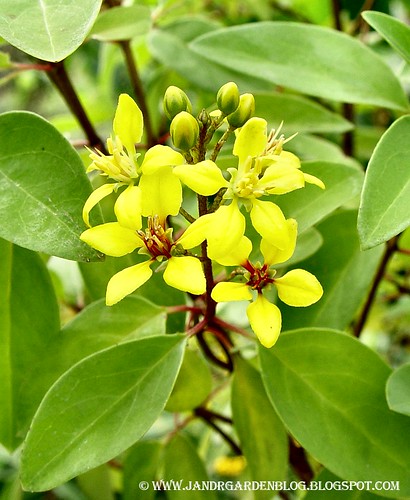skip to main |
skip to sidebar
As I walk through the garden in the late evening taking pictures, I notice all the insects settling in for the night. The butterflies hang from protected spots in trees and shrubs and the bees curl up comfortably on flowers. I have just recently begun to notice, the instant the sun disappears over the horizon; the bees are ready for a rest. They curl their little antlers up, tuck their chins to their chests and off to sleep they go.
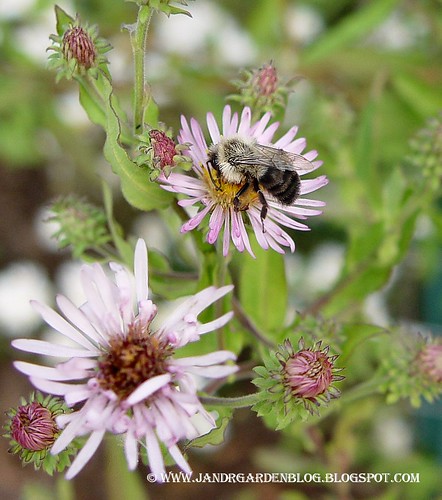
Late every afternoon I stroll around the garden to watch them nestle into beds of asters, sunflowers and sage blooms. I was thinking to myself; now that’s the life, fly around all day drinking sweet nectar and passing out exhausted on a flower. After the initial enthusiasm and amazement of my new discovery began to subside, I started to wonder why they do this. So, I set out to find the answer to my question. On my little research journey, I discovered bees are amazing creatures.
To answer the original question, they sleep on the flowers because they have no where else to rest. They are little boy bees that have been cast out from their homes. This is the story of how they came to live as they do. BEE fore warned this story does not have a fairytale ending.
In the very first days of spring, when all the flowers begin to bloom, the queen bees make their appearance. They are the large bees you see slowly flying around during the first warm days of the growing season. They are searching for the perfect place to build a palace. When she finds an area suited to her needs she gathers pollen to make a soft place to lay about eight eggs. After the eggs are laid, she will cover them with a thin layer of wax secreted from the gland on her sternum. Then, she will rest on them just like a chicken and raise her body temperature to a range between 98 and 102 degrees Fahrenheit. From this point forward, she will only leave the nest for periods of 30 minutes or less to gather pollen and nectar for nutrition. After about 20 days, the first brood of workers will be born and the queen commits the remainder of her life to laying eggs, leaving the nest building and daycare to the workers.
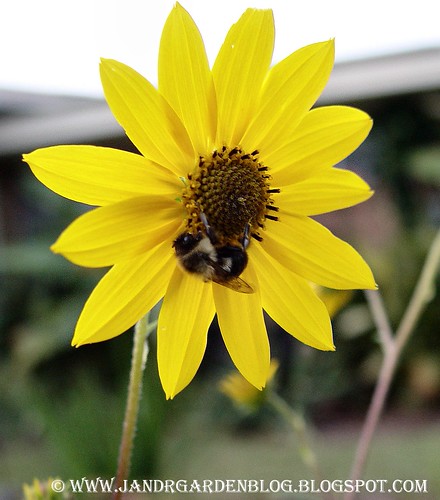
Bumblebees are very much unorganized nest builders compared to honey bees, but they are extremely efficient when it comes to recycling materials. The nest of a bumblebee rarely gets larger than half the size of a baseball. As the brood cells are emptied they become storage areas for nectar and pollen. As new workers emerge from the cells, house keeping workers will take the removed cell caps and use them to enclose other eggs. They waste very little materials when building the nest. As the larvae grow, the nursery workers feed them a combination of pollen and nectar that has been kneaded into a substance referred to as Bee Bread.
During the nest building process, the queen only lays eggs that will produce worker bees, all of which are female. 66% of these workers will remain at the nest constructing cells and caring for the young and the remaining 34% will gather food. You can recognize the workers that leave the nest by the large pouches of pollen on their hind legs. When she is satisfied with the size of the home her workers have made, she will begin laying the eggs for drones and queens. The queen determines what the eggs will be before she lays them. The female worker bees, which are born from fertilized eggs, do not have the hormones to produce ovaries. As a result, about mid summer the queen begins producing fertilized eggs with the necessary hormones to become queens and unfertilized eggs that will become the drone class of bees consisting entirely of males.
When the queens and drones are born, the queens are allowed to stay until they choose to leave, but the drones are forced to leave and never return again. The male bees are sent out into the world to feed on nectar and sleep on flowers until they meet their tragic end. The drones are the smallest of bumblebees and have no stingers, so they are completely harmless. Another interesting fact I learned concerning bumblebees is the buzzing that you hear is not coming from their wings. The buzz is actually the sound of them vibrating their bodies to shake the pollen off their antlers and out of their body fuzz. You primarily hear this noise from drones because they have no use for pollen.
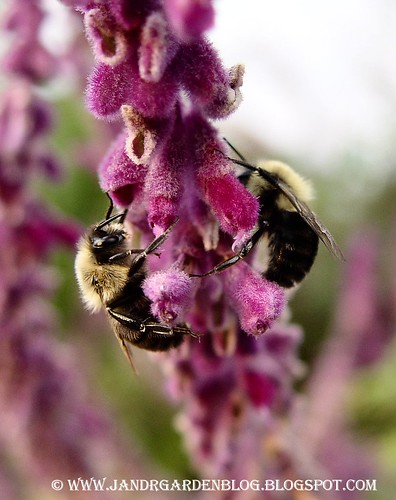
So, the little bees we see sleeping on flowers are the homeless males whose sole purpose is to fertilize the new queens when they decide to leave the nest. This is where the poor male will meet his end. The breeding process between a drone and queen lasts about 30 minutes. When the queen has decided the mating is complete, she rips away from the drone tearing him so severely he is left to die. Poor thing, he is thrown out of his home at birth and when something good finally happens, it kills him. The young queen will repeat this process with several drones, storing up sperm in a special internal container called a spematheca. In the late fall she burrows under ground to hibernate until the spring.

The old queen, workers and remaining drones will perish with the first frost. The nest is now abandoned and will deteriorate over time. I learned so much more that I would love to share with you, but it’s simply too much information. But, if you have ever wondered why the little bees sleep on flowers you now have the answer.
I can’t tell you the joy felt from the butterflies we’ve had in our garden this past season. The large bed at the end of the patios is an unorganized cluster of blooms that has been the feeding ground for a kaleidoscope of guests. No one knows for certain why we call them butterflies. The word can be traced back as far as the earliest parts of the eighth century. One notion is that butterflies would fly into kitchen to feed on uncovered milk and butter. The German word for butterfly is milchdieb, which when translated means milk thief. Legends and Myths suggest fairies stole butter in the form of these creatures at night. Other theories suggest it is because yellow is a primary color for them. My father has called them Flutter-bys for as many years as I can remember, and truthfully, what describes them better?
There are over 250 varieties of North American Skippers and over 3000 world wide. This is a picture of a male Fiery Skipper. He’s a wonderful orange color with brown spots. The female has the exact opposite colors, brown with orange spots. They are sometimes called Grass Skippers because as caterpillars they feed on St. Augustine and Bermuda grass. I’ve read that the caterpillars are pinkish green in color and have black heads. I’ve also read that they are hard to see because they protect themselves from predators by staying close to the grass roots. The adult butterflies keep their wings in a type of jet plane position until they warm up, and then they sometimes close them. If you have ever tried to take a picture of one you’ll see they move just about that fast as well.
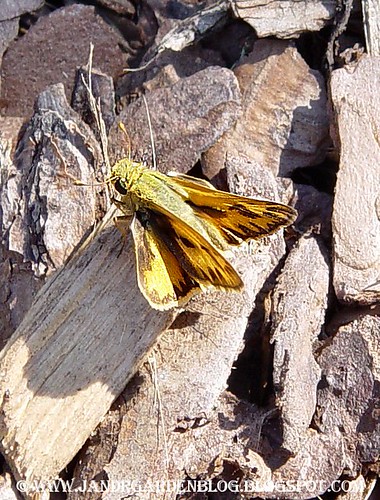
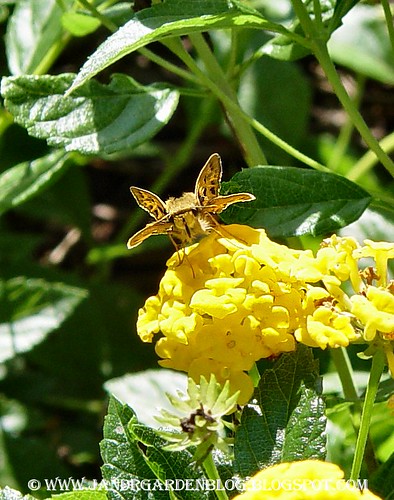
The Dun Skipper is dark brown in color. The male has a dark colored stripe on each forewing called a stigma. A stigma is a dark or black colored streak of scales on the front wing that produces pheromones to attract females. The females are the same color except they have small light colored spots in the center of their forewings. Like the Fiery Skippers, they prefer sedges in the caterpillar stage of their lives. As adult butterflies they prefer moist areas near swamps, streams or meadows and choose white, pink or purple flowers over all others.

This little fellow is a male Common Checkered Skipper. The only distinguishable difference that I know between the male and the female is the color. The male has a bluish silver body with hair spreading to the wings and the female has a dark grey body that has little or no hair. The host plants for these butterflies before they earn their wings are Mallow plants. They prefer Apricot Globe Mallow and Hollyhocks. As adults they like the nectar of all flowers but prefer Asters above all others.

This Variegated Fritillary is a butterfly I don’t see that much of in our area. The host plant for this autumn colored beauty is varied. Some of the plants they will use as a host plants are May Pops, Violets, Sedum and Portulaca. As adult butterflies they tend to be partial to the nectar of Butterfly Weed, Common Milkweed and Red Clover. They can overwinter in the deepest parts of the South and in other areas they may migrate.
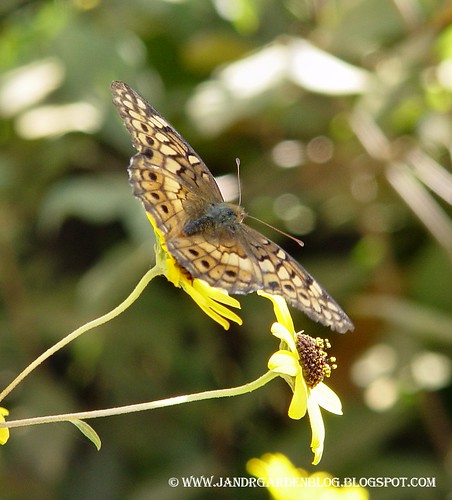
The yard is awash with Gulf Fritillary butterflies right now and I can’t resist the urge to post several pictures of them. I’ve always loved their bright orange color and when I see those perfectly colored silver spots on the underside of the wings I am simply amazed. How do they make that color? If you want these guys in your garden you should plant Passion Vines and lots of Lantana. Passion Vines are their host plants of choice, butthey find the nectar of Lantana delicious.
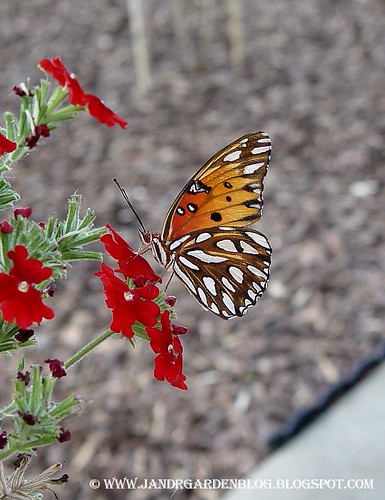
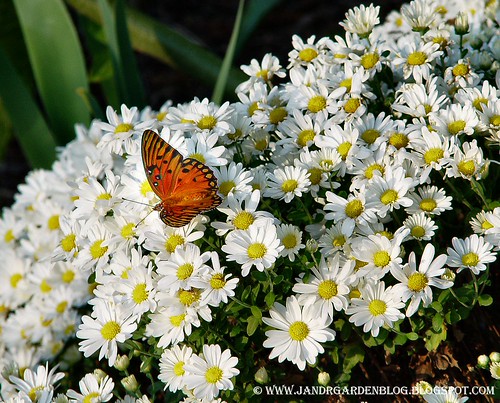
My favorite butterflies are the tattered ones. I know they have lived long fulfilled lives...

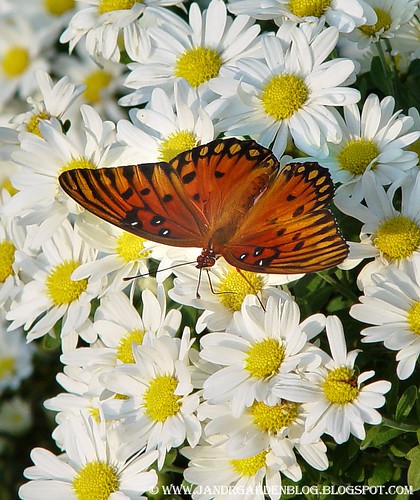
Painted Ladies are another type of butterfly we rarely see in our garden. Once we get our Hollyhocks growing and plant a few more varieties of sunflower perhaps we can entice them to visit us more often. Who knew that a butterfly could have such finicky tastes when it comes to flower nectar. The one is this picture has tattered little wings. How many more trips to Mexico can it make for the winter?

The Eastern Tiger Swallowtail has always been my very favorite butterfly. The one in this picture is a female. You can tell the difference by the blue on the back wings. A male has very little or no blue on its wings, most of the time just a spot on each one. The can be either yellow with black stripes or just black. In the past I’ve mistakenly posted a Black Tiger Swallowtail as a Pipe Vine Swallowtail. That picture is listed below and you can better see the blue that indicates a female in the striped variety. One really interesting thing I learned is that sometimes these butterflies can suffer from gender confusion and be both male and female. When this happens they can have yellow wings with black stripes on one side and have black wings on the other. Or, the can also become some of the most amazing patterns and colors described as Mosaic. When this happens, the butterflies are called Gynandromorphs. Tiger Swallowtail butterflies tend to use trees as host plants, Tulip Poplar, Wild Black Cherry and Sweet Bay Magnolias to name a few.
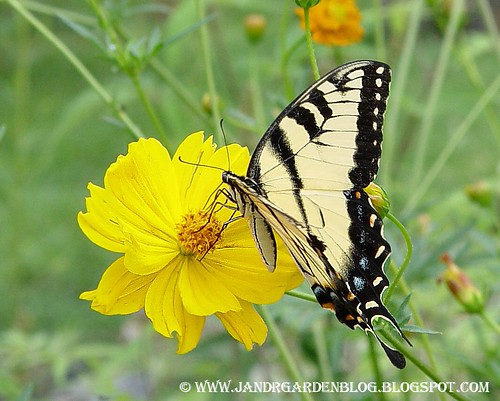
This is a black female...
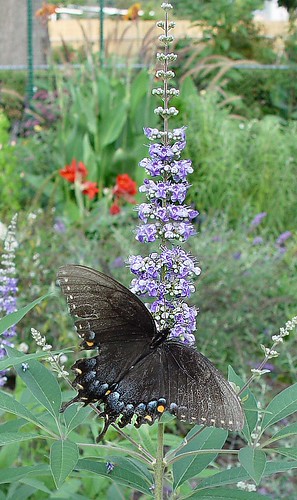
A few years back, the weather was starting to cool off at night and it was time to move in the house plants. One particular night the temperature dropped really low extremely fast and it was late in the evening when I drug the plants in for the night. The next morning I woke up, walked into the kitchen and the room was absolutely filled with fluttering Sulfur butterflies. They were everywhere, what a wonderful thing to wake up to in the morning. It’s not every day that you arrise from slumber to a house filled with butterflies. Evidently they had settled in the plants for the night and had become immobile from the cold. When the heat from the house warmed them up they were ready to fly again. Cloudless Sulfur butterflies will be in your garden no matter what flowers you have planted. But where ever you find Wild Morning Glories you are sure to find these yellow gems.

No butterfly post would be complete without a photo of a Monarch. The one pictured below is a male drying his wings. They are easily identified by the black dots on the rear wings. These are the glands that produce the pheromones to attract the ladies. We make certain to keep plenty of Scarlett Milkweed planted in our garden to keep these guys laying eggs and to provide the caterpillars something to munch on while they grow. After the show of Monarchs we had a couple of weeks ago, you can rest assured we will find a place for more milkweed in the spring.

It would be impossible for us to plant all the host plants we would like to have; we simply don’t have the room. We will certainly do what we can to keep attracting butterflies to our garden. Nothing has given me greater pleasure than these wonderful little creatures have this past summer. It already gives me something to look forward to next season.
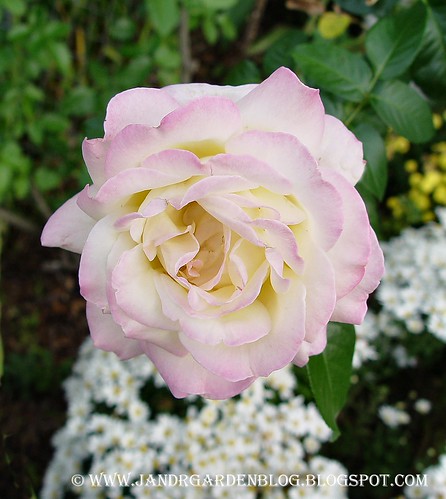
Today is the one year blogiversary of Creating Our Eden. One year and we are fast approaching 10,000 site views. Jamie and I would like to say thank you to all our regular readers, without you I probably would not have maintained this blog.
Since I was a little boy I’ve loved taking pictures. I use to run around with a Kodak Instamatic, the kind that had the disposable flash cubes that would sit on top. I would take all kinds of pictures of flowers and landscapes and pretend I was a professional photographer. The film was cheap, but I could never afford to get any of the pictures developed and when I did, most of them were never really that good.
A second passion of mine has always been writing, I actually started a book once. Much to the disappointment of my composition teacher I never attended college. She was certain I had a talent for writing and I would do great things. I had the highest grade point average in my senior class. I look at my grammar now and it’s amazing how much you can lapse in a period of 24 years. I tend to overlook the simplest of errors as I reread my posts. I catch them a week later and scold myself for being so erroneous. But, then I realize most people aren’t really that concerned with my mistakes or they do a good job of keeping it to themselves.
Blogging has awakened three things in me that have been asleep for way too many years. A love of gardening, photography and writing are things that bring me peace of mind and pleasure. I don’t know why I had chosen to deny myself these things that I enjoy so much. I suppose some where down the road someone has told me I wasn’t good enough at it or it was a waste of time and I believed them. Even though we shouldn’t, I think we all need some form of validation from time to time that we are doing a good job. The comments and emails I have received from maintaining this blog have done just that and resurrected more things in my life than you could possibly imagine and for that I say thank you.
I raise my spade in a toast to you. Here’s to the incredible new friends Jamie and I have made thru this bog - to many more years of blogging, gardening and photography - and a lifetime filled with infinite possibilities. Thoughts become things, so choose the good ones.
As our gardening skills have progressed, Jamie and I have become fond of vines. We’ve started to get a pretty good collection. There is still a lot of trial and error going on in our garden and we are learning as we go along. Some of the vines we decided to grow this year we will keep and some of them we will remove.
This first vine is a Purple Hyacinth. I’m sure everyone out there has seen this one before. We started this vine from seed and to begin with it was a major disappointment. We petted and pampered it all summer and it just sat there pretty much doing nothing. August came along and I was just about ready to snatch them all up and put them into the trash and just as if they had heard those very words they hit a growth spurt. They’ve been blooming like crazy ever since. The Purple Hyacinth Vine will most definitely be a keeper next year.
Purple Hyacinth Vine

This next flower is a bloom from a Cypress Vine. This vine is easy to grow and the humming birds absolutely love it. They are so easy to grow, as a matter of fact; I’ve been trying to get rid of this vine for over ten years. If I am fortunate enough to get rid of it, never again will it be purposely planted in our garden. A very, very pretty vine, but not one I care to have any longer.
Cypress Vine

The next photo is a picture of a Cardinal Vine bloom or at least that’s what I’ve been told. I haven’t been able to find a single picture of this vine online. The leaves are trident shaped and do not look like the other pictures I’ve seen. You can barely make them out in the back ground of the photo. The only reason this vine is still in the garden is because it grew while my back was injured and I wasn’t able to pull it up. Now that Jamie has seen it, he refuses to let me get rid of it or the cypress vine. The ones that have grown can stay, but I will remove everyone that I can next year. Beautiful flowers, but this one gets the thumbs down from me.
Cardinal Vine

This is clematis ‘Galore’. It’s a wonderful shade of purple and I love it! It is one of five very sick clematis that Jamie and I bought on clearance. We chopped it down to the base and it has rewarded us with new growth and blooms. It and the other four we bought are still in the pots we bought them in. It is a definite keeper, but the big question is where are we going to put it?
'Galore'

‘Sugar Candy’ is another one the lovely clematis we purchased that seems to benefit well from a good haircut. Alas, it has yet to find a home either. That sounds like a good project for this coming weekend. It’s not that we don’t have plenty of fences to plant them on, but if we do that they may fall victim to the weed whacker or a careless push with the lawn mower. They need to be in a bed somewhere.
'Sugar Candy'

‘Tangerine Beauty’ cross vine is another addition to the mix this year. We have two of these planted on each side of one of the arbors. It hasn’t bloomed yet, but it is filling in very nicely.
'Tangerine Beauty'

This sky vine, or Blue Orchid vine as it is sometimes called, was a gift from our friend Carol. She dug it up from her yard and gave it to us the same weekend we also bought one from a flea market. It has beautiful bluish/purple colored blooms. This is most certainly a keeper. The one we bought from the lady at the flea market has slightly larger leaves that are a different color of green. It’s very possible we have two different kinds, but I will not know for certain until the other one blooms.
Blue Orchid Vine
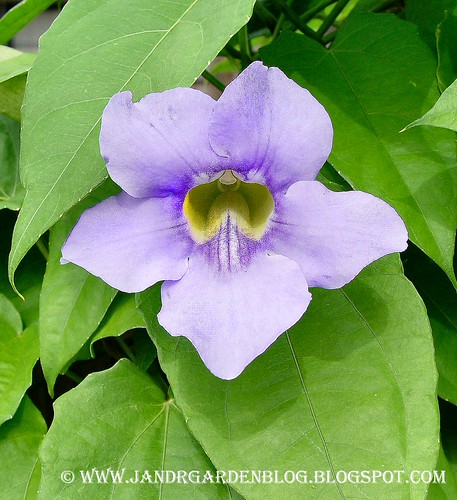
To me, the buds are equally as beautiful as the actual blooms.
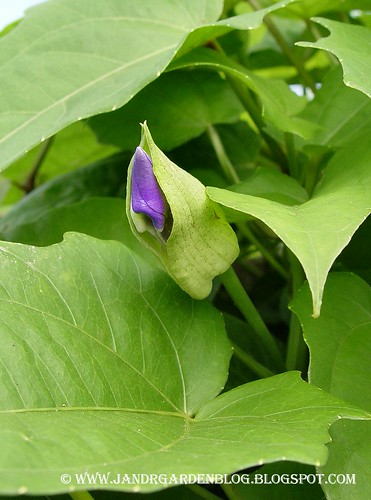
We recently started to work on a new bed by the driveway this past weekend. It was my original intentions to have that bed competed by now. The past eight weeks I’ve been unable to do anything in the yard so we are falling behind schedule. ‘Mardi Gras’ is one of two honey suckle vines to planted on a split rail fence that will go to the rear of that bed. It has a nice frilly flower that reminds me of the ones that use to grow wild in my parent’s back yard.
'Mardi Gras'

‘Magnifica’ is the second vine to be planted on the fence I just mentioned. That is, if it survives. It has some type of disease and it is still in intensive care. It’s starting to put out new growth so I think it’s going to be okay. It just needs to be put in the ground in the new bed so it can start absorbing all those delicious minerals from the soil. No one can do a better job than Mother Nature when it comes to taking care of her ailing babies.
'Magnifica'
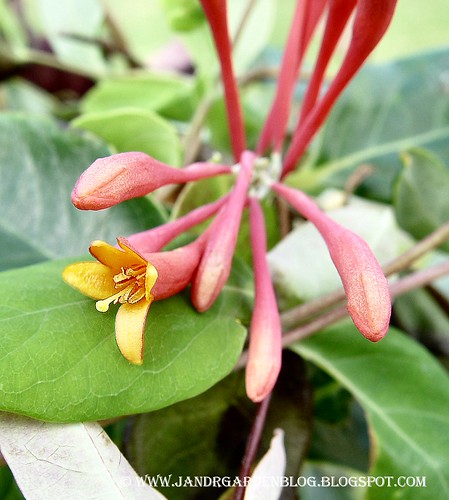
This Snail Vine is a super fast grower with really pretty flowers. I’m not certain it will stay in the garden next year though. It grows way too large for the area we planted it in and I’m not sure where we can put it. Jamie came up with an idea that I really liked. I’m not going to share it with you just yet, but I’ll be certain to post about it when we make it a reality. The Snail Vine gets a two thumbs up from me, just make certain you put it somewhere it has enough room to spread its little tendrils and grow.
Snail Vine

Ahhhhhhhh, the scent of ‘Confederate Jasmine’, we planted some on an arbor this year and the fragrance was so incredible in the evening, that we planted a twenty-three foot wall of it at the entrance to our garden. Need I say more about this vine?
Confederate Jasmine
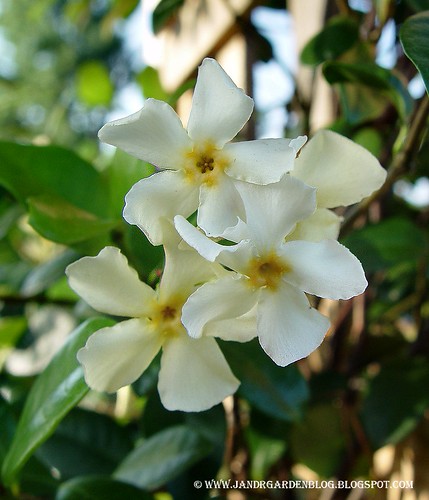
In addition to the vines I’ve shown here, we also have Dutchman’s Pipe Vine, Hyacinth Bean ‘Alba’, ‘Sweet Autumn’ clematis and Climbing Hydrangea. I really wanted to have some Scarlett Runner Beans to plant this summer too, but it just didn’t happen. Maybe next year we will find some. Vines are a great way to add height your garden and create privacy. If your garden isn’t already filled with them, there is no better time than the present to get started.
I really have to brag on our little garden. Even though the foliage is really starting to look, not so pretty, we still have lots of pretty blooms to enjoy. Jamie and I made a conscious effort to try and purchase plants for all seasons this past spring. Looks like we did a pretty good job of it so far and we will keep putting some careful thought into it from this point forward.
This first picture is of ‘Galore’ clematis and Thryallis. I’m not certain how the Thryallis is going to handle the winter in our zone, but we are soon to find out. I’m hoping it does okay. If not, I’m certain we can find something else to take its place.

This is the first time ‘Clarence’ has decided to bloom. Jamie and I bought this Iris earlier this spring. Isn’t it a beautiful flower?

The variegated sedum is doing well, but the chrysanthemums just about choked it out this year. To be truthful, if I had to choose between the mums and sedum it would be the mums. They’re gorgeous right now.
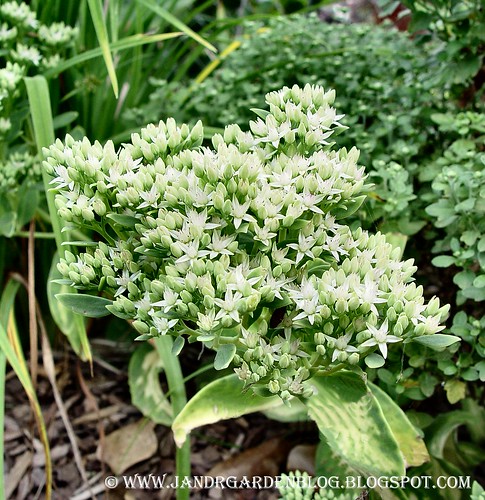
Jamie and I got out and divided a lot of the cannas this past weekend. Our friend Carol left with two kitchen garbage bags filled with tubers. The blooms are still pretty, but the leaf rollers did a number on the foliage. Next year, I’ll stay on top of the problem. This is ‘President’ and it’s followed by ‘City of Portland’.
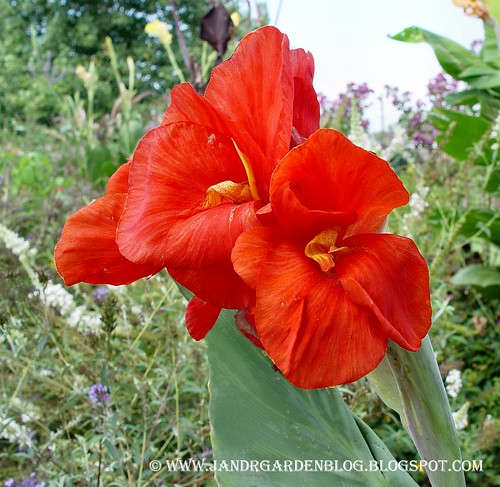
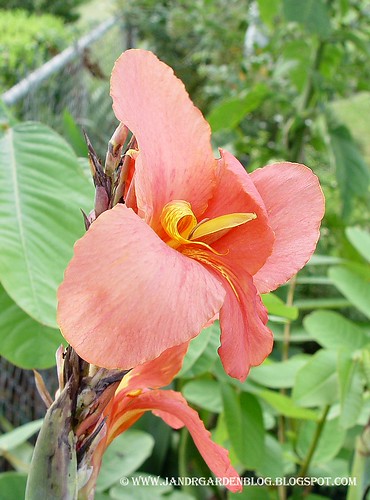
For the most part, it appears as if the huge bed we placed at the end of the patios is becoming a butterfly garden. Next year, in addition to all the other plants in the bed, it should be blanketed in trailing Lantana. This it one of the five cultivars we have. It’s called ‘Lemon Drop’, we got it on our little vacation to Florida this year.
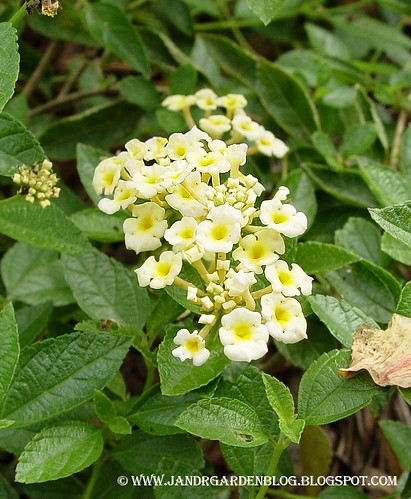
This next flower we purchased at a flea market in the southeastern part of the state. When I asked the little lady we bought it from what it was called, she said “A tall yellow daisy.” So, that’s all I know to call it. She wasn’t joking either, this thing gets over eight feet tall.

Last but not least, we have my grandmother’s rose. There is absolutely no telling how old this plant is, it was at her house for as many years as I can remember. When she became ill, I dug this up before her house was sold. This picture does not do it justice.

I've been terribly tardy with my posting. This time of year the days pass much quicker for me and I find myself more tired than usual. When the leaves start to fall so does my energy level and I have to work very hard to keep myself motivated. Some years are better than others. I sense the air becoming dry and dusty and the colors appear muted and all the brilliant hues disappear. With it, so goes my enthusiasm. Today we got rain, not really enough to amount to anything, but maybe enough to wash out what ever it is in the air that makes me feel so yucky, be it emotional baggage or just the pollen from the golden rod.
The garden is starting to show signs of weariness all over the place. I think I can safely say it has reached its peak. It could use a good haircut in some places, but I still see blooms and I just can’t bring myself to do it. My and Jamie’s lives have been so hectic we’ve been running around like mad men. Hopefully we can dedicate some time to the garden this coming weekend. We do however still have some blooms, so why don’t we take a looks at some of them?
All year I’ve been eagerly awaiting the Monarchs. The Scarlett Milkweed has been blooming its heart out and not a single Monarch. Last year Jamie and I photographed the entire transformation from start to finish. The birth of the butterflies was incredible.
Just when I had given up hope that they would find us this year, they descended on us in huge numbers. One day there were none and the next those three plants were filled with more Monarchs than it was possible to count. I know I probably should have left them alone, but I couldn’t resist the urge to walk out to the plants several times a day. My presence disturbed them so I would be instantly surrounded in a cloud of butterflies. Talk about magic! It was an incredible feeling. They stayed for about three days, several still remain.
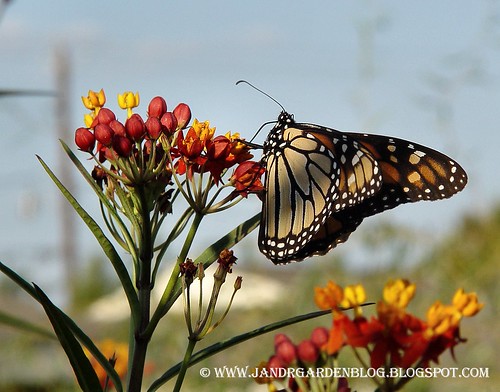
Mr. Jamie has decided that he wants to collect Dahlias. ‘Kiss Me’ is the first in his collection and is one of the cultivar from the Happy Single collection. He also has ‘Party’ which isn’t in bloom yet. I love unusual and complicate blooms, but the simple ones also have a special place in my heart. They remind me of the flowers we all drew as children. These plants bloom from summer to frost and are cold hardy 20 to 10 degrees Fahrenheit. They grow very fast and can reach heights of 28 inches and spread 18 inches wide. They are low maintenance and require just a little dead heading to keep them going. The foliage on the two we have so far is a deep purple to bronze color.
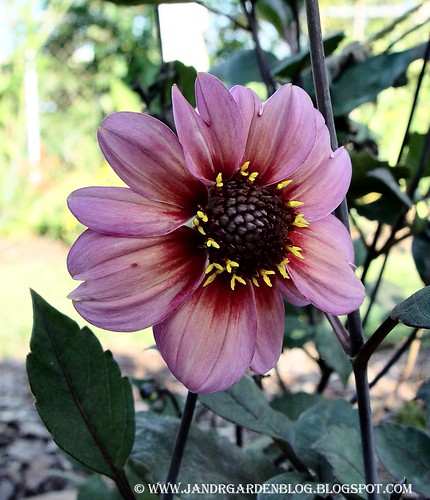
Our ‘Aztec Lily’ is blooming right now. I was concerned that it may have been one of the plants that had been carried off by the bull dozer. I’m so glad it survived. It’s a member of the Amaryllis family and is a native of Mexico and Guatemala. It’s tropical in nature but can survive winters in zone 8 with some mulch to protect the bulb. Its blooms are brilliant red and can appear from spring to late summer. I’ve read that it tends to put on a better show of flowers when allowed to become a little crowded. It prefers full sun, but can do well in partial shade. Yes, that is a yellow mum it planted by, I know some of you are thinking red and yellow shouldn't be together. Maybe you should explain that to the Cleopatra Canna.
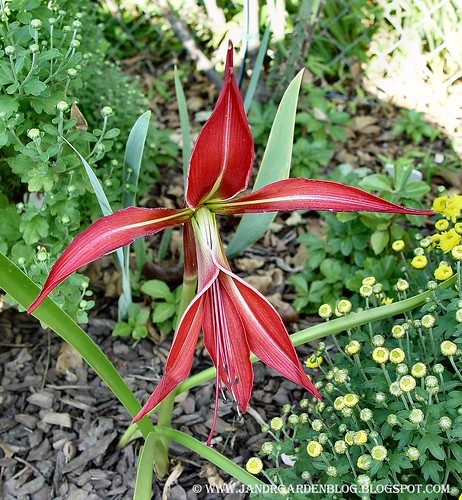
The jury is still out on the Morning Glory Tree. I can’t make of mind if I like it or not. It’s an awful lot of plant for the small amount of flowers that it puts out. My friend Carol and I were talking about it this past week and we wondered if we cut it back in its earlier stages of growth if it might become a little bushier and not so tall. Producing more limbs and more blooms, I guess it’s safe for another year and I’ll give you a report next summer.
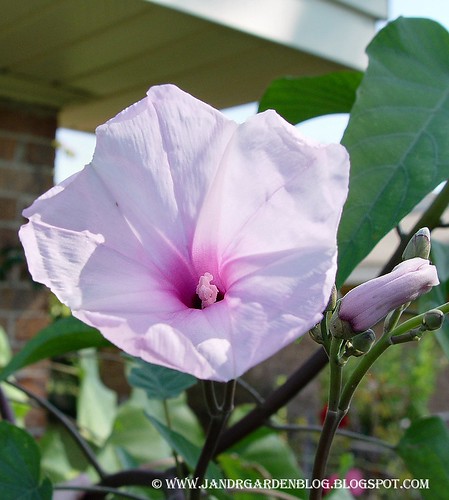
Speaking of our friend Carol, one of her favorite plants is Thryallis. This is a fast growing shrub that stays in constant bloom spring through fall. If you love the color yellow and have room in your garden for another shrub, then this is a plant you might want to consider. The tag says it’s hardy to zone 9 but can stand temps to 20 degrees so I think it should survive here in zone 8 with no problems. Time will tell.
